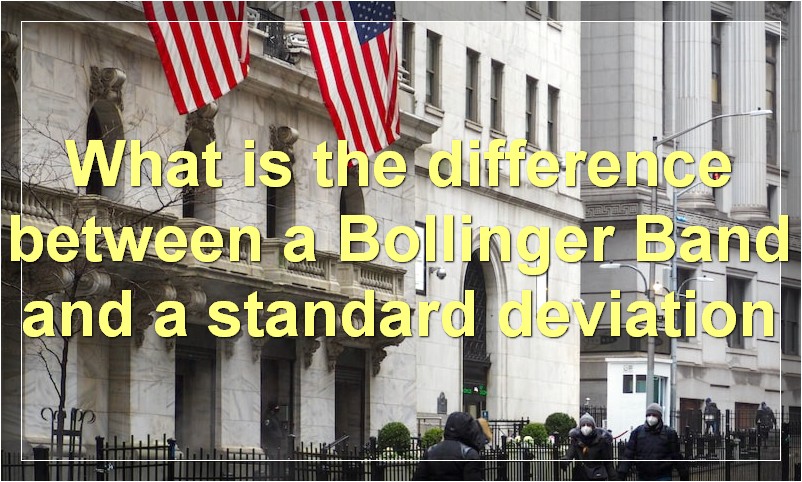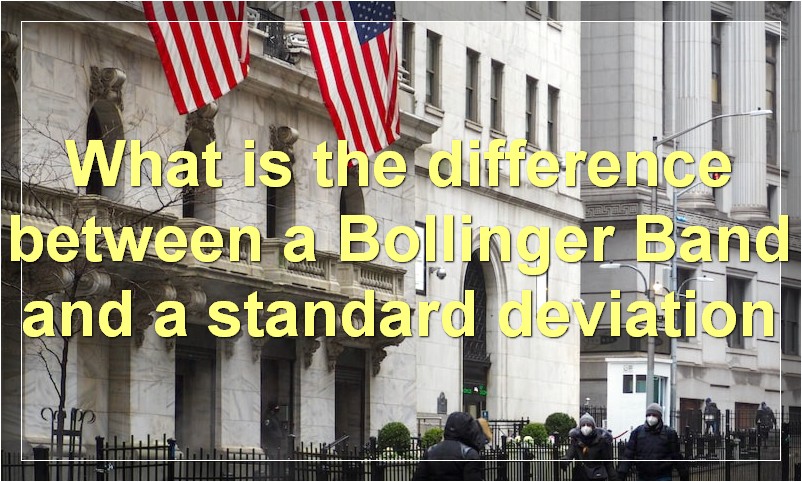If you’re new to technical analysis, Bollinger Bands are a great place to start. In this article, we’ll cover the basics of what they are, how they work, and how you can use them in your own trading.
What is a Bollinger Band
Bollinger Bands are one of the most popular technical indicators used by traders in all markets. But what is a Bollinger Band and how can it help you trade?
A Bollinger Band is simply two lines that are plotted above and below a security’s price on a chart. The lines are generated by calculating the standard deviation of the security’s price over a certain period of time. The Bollinger Bands indicator was developed by John Bollinger in the 1980s.
The upper line is typically 2 standard deviations above the security’s 20-day moving average, while the lower line is 2 standard deviations below the 20-day moving average. This creates a band around the moving average that can be used to identify periods of high and low volatility.
Bollinger Bands can be used to trade a variety of strategies, but they are most commonly used to trade breakouts. When the price breaks out above the upper Bollinger Band, it is considered a buy signal, while a breakout below the lower Bollinger Band is considered a sell signal.
Breakouts can be tricky to trade, so many traders will wait for confirmation before entering a trade. One common confirmation method is to wait for the price to close outside of the Bollinger Band before entering a trade. This ensures that the breakout is valid and reduces the chances of being caught in a false move.
Bollinger Bands can also be used to trade reversals. If the price is trending higher and then breaks below the lower Bollinger Band, it could be a sign that the trend is reversing and that a selloff may be imminent. Similarly, if the price is trending lower and then breaks above the upper Bollinger Band, it could be a sign that the downtrend is coming to an end and that an upswing may be about to begin.
The key with Bollinger Bands is to use them in conjunction with other technical indicators or chart patterns to confirm your trading signals. They should not be used as standalone signals.
If you’re looking for an indicator that can help you trade a variety of strategies with confidence, then Bollinger Bands may be worth adding to your toolkit.
What is the difference between a Bollinger Band and a standard deviation

A Bollinger Band is a tool that is used to measure market volatility. It is made up of an upper and lower band that are placed two standard deviations above and below the 20-day moving average. The bands expand and contract as volatility increases and decreases.
A standard deviation is a statistical measure that measures the dispersion of a dataset relative to its mean. It is calculated by taking the square root of the variance. Standard deviation is a important tool that is used in many different fields, such as finance, engineering, and science.
How do Bollinger Bands help traders
Bollinger Bands are a technical indicator that are placed above and below the price on a trading chart. They help traders to determine whether prices are high or low in relation to previous prices. Bollinger Bands consist of a upper band, lower band, and a moving average in the middle. When prices are high in relation to the upper band, it is considered overbought, and when prices are low in relation to the lower band, it is considered oversold. Bollinger Bands can help traders to make decisions about when to buy or sell a security.
What is the history of Bollinger Bands
Bollinger Bands are a technical analysis tool created by John Bollinger in the 1980s. The bands are based on a standard deviation calculation of the underlying security’s price action. Bollinger Bands typically contain 99% of price action, which means that price tends to stay within the upper and lower limits of the band. When prices break out of the Bollinger Band, it is often an indication that a new trend is forming.
Who created Bollinger Bands
Bollinger Bands were created by John Bollinger in the 1980s. They are a technical analysis tool used to measure volatility and predict future price movements.
Bollinger Bands are comprised of three lines: an upper line, a lower line, and a middle line. The middle line is typically a simple moving average (SMA), and the upper and lower lines are typically 2 standard deviations above and below the SMA, respectively.
standard deviation is a statistical measure of how much prices vary from the average price. Bollinger Bands widen when volatility increases and narrow when volatility decreases.
The theory behind Bollinger Bands is that prices tend to stay within the upper and lower lines during periods of low volatility, and break out of the lines during periods of high volatility. This breakout can be used to signal a potential change in trend.
What are the three components of a Bollinger Band

A Bollinger Band® is a technical analysis tool that provides a relative definition of high and low prices of a security, based on past market action.
Most charting packages include Bollinger Bands® automatically. They are typically drawn as three lines. The middle line is usually a Simple Moving Average (SMA) of the security’s price. The upper band is the SMA plus two standard deviations, and the lower band is the SMA minus two standard deviations.
The standard deviation is a statistical measure of volatility. When the markets are quiet, the bands will be close together. When the markets are volatile, the bands will be far apart.
Bollinger Bands® can be used to identify potential entry and exit points for trades. For example, if a stock is trading at the upper end of its Bollinger Band®, it might be considered overbought and ripe for a pullback. Conversely, if a stock is trading at the lower end of its Bollinger Band®, it might be considered oversold and due for a bounce higher.
One caveat: Bollinger Bands® don’t provide absolute buy and sell signals on their own. They should be used in conjunction with other technical indicators, such as support and resistance levels, moving averages, and candlestick patterns.
How do you calculate Bollinger Bands
Bollinger Bands are a technical analysis tool that is used to measure market volatility. They are created by using a simple moving average (SMA) and adding or subtracting a standard deviation. Bollinger Bands can be used to trade a variety of markets, including stocks, forex, and commodities.
There are two main ways to calculate Bollinger Bands. The first is to use a computer program or online calculator. The second is to do it manually.
If you want to calculate Bollinger Bands manually, you will need to know the following formula:
Bollinger Band = SMA + 2 x Standard Deviation
To calculate the SMA, you will need to add up the closing prices of a security over a certain period of time and then divide that number by the number of days in that period. For example, if you wanted to calculate the SMA for a stock over the past 20 days, you would add up the closing prices for each of those days and then divide by 20.
To calculate the standard deviation, you will need to take the square root of the sum of the squares of the differences between each closing price and the SMA. For example, if the stock’s closing prices for the past 20 days were 10, 11, 12, 13, 14, 15, 16, 17, 18, 19, 20, 21, 22, 23, 24, 25, 26, 27, 28, and 29, the standard deviation would be calculated as follows:
Standard Deviation = √((10-19.5)²+(11-19.5)²+(12-19.5)²+(13-19.5)²+(14-19.5)²+(15-19.5)²+(16-19.5)²+(17-19.5)²+(18-19.5)²+(19-19.5)²+(20-19.5)²+(21-19.5)²+(22-19.5)²+(23-19.5)²+(24-19.5)²+(25-19.5)²+(26-19.5)²+(27-19.5)²+(28-19.5)²+(29-19.5)²)/20
Standard Deviation = √(81+64+49+36+25+16+9+4+1+0+1+4+9+16+25+36+49+64)/20
Standard Deviation = √(460/20)
Standard Deviation = 3.16227766016838
Now that we have all of the necessary information, we can plug it into the formula to calculate the Bollinger Band:
Bollinger Band = 19.5 + 2 x 3.16227766016838
Bollinger Band = 25.9645553203368
What is an example of a Bollinger Band trading strategy
Bollinger Bands are a technical analysis tool used by traders to measure market volatility. They are created by applying a standard deviation to a moving average. Bollinger Bands typically have two outer bands and a middle band. The upper band is the moving average plus two standard deviations, while the lower band is the moving average minus two standard deviations. The middle band is simply the moving average itself.
Bollinger Bands can be used in a number of different ways, but one common Bollinger Band trading strategy is to buy when the price breaks out above the upper band, and sell when it breaks below the lower band. This strategy seeks to take advantage of periods of high market volatility, as prices are more likely to move sharply in either direction when market conditions are particularly volatile.
What are some common mistakes made when using Bollinger Bands
One common mistake made when using Bollinger Bands is not adjusting the bands accordingly to changing volatility. For example, if a stock has been trading in a relatively tight range for an extended period of time, the standard deviation of price changes will be lower and the Bollinger Bands will contract. If the stock then breaks out of its range and becomes more volatile, the standard deviation will increase and the Bollinger Bands should expand. Not doing so can lead to false signals.
Another mistake made when using Bollinger Bands is failing to use them in conjunction with other technical indicators. Simply because a stock is trading outside of its Bollinger Bands doesn’t mean it’s automatically overbought or oversold. It could just be experiencing higher than normal volatility. Looking at other indicators such as RSI or MACD can help confirm whether or not a stock is truly overbought or oversold.
Finally, some investors make the mistake of thinking that all touch points on the Bollinger Bands are equal. This is not the case. The further away from the 20-period moving average a touch point is, the more significant it is. For example, a touch point at the upper Bollinger Band 2 standard deviations away from the 20-period moving average is much more significant than one that only 1 standard deviation away.
Are there any other uses for Bollinger Bands besides trading
Bollinger Bands are a popular technical indicator that traders use to help identify potential trading opportunities. While Bollinger Bands can be used for a variety of different trading strategies, they are most commonly used to trade breakouts and reversals.

